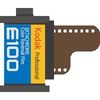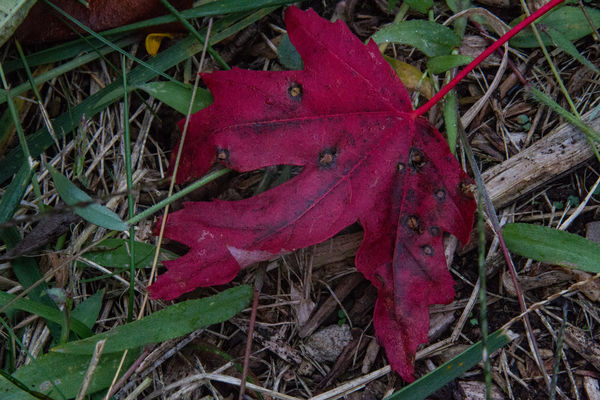How Do I Improve Manual Focus Skills?
Oct 9, 2020 16:07:46 #
When I shot with an ftb and manual lenses, everybody was telling me to hurry up. Manual focusing was not quick when you wanted to do it right and you weren't a pro doing it all day everyday. BUT, my photos turned out great. Now one of my biggest problems is getting good focus with AF. It seems like I've gone backwards.
Oct 9, 2020 16:08:34 #
kenievans wrote:
I was able to adjust aperture and the camera did adjust the exposure although when I look at the metadata it did not capture the Fstop I used, just the ss and ISO. I attached one of the shots that I processed in PS. I will try it next time on the tripod.
Hey Keni, the FD lenses have no electronics. They will never report the aperture back to the camera to capture into the EXIF. The magnifying button, upper right on back of the T6 body, below the Mode dial. In LiveView, you can position an AF point and then use the magnifying button to 'zoom in' at that point. This image seems in better focus on the background leaves rather than the blossoms, where a sharp focus on the right (our view) stamen would seem where this composition should be focused.
Oct 9, 2020 16:12:45 #
kenievans
Loc: Dallas
SteveR wrote:
When I shot with an ftb and manual lenses, everybody was telling me to hurry up. Manual focusing was not quick when you wanted to do it right and you weren't a pro doing it all day everyday. BUT, my photos turned out great. Now one of my biggest problems is getting good focus with AF. It seems like I've gone backwards.
My problem with AF is getting the right thing in focus.

Oct 9, 2020 16:14:50 #
kenievans wrote:
My problem with AF is getting the right thing in focus. 

Consider these ideas: How to obtain sharp images in digital photography
Oct 9, 2020 17:03:44 #
stevefrankel wrote:
One very obvious thing you've probably already don... (show quote)
Easy to recall that boilerplate from when it actually worked, before AF SLRs, back when SLRs has textured focusing screens. But once plain viewing screens replaced focusing screens i(late 80s) it was game over. Your post is the perfectly good instructions for cameras that haven’t been made for decades.
Oct 9, 2020 20:14:01 #
There may be some issues with the equipment, the adapter or some incompatibility with an older lens on a more current body, but let's put that aside for a moment and talk about focusing technique.
Since the advent of autofocus, there's little conversation about MANUAL focus methods.
For the purpose of a basic test and practice, mount the camera on a tripod (using the tripod socket or the socket on the lens collar if applicable) and use a faster s shutter speed, and you may want to lock up the mirror after focusing before exposing. Use a tripper cord, or remote trigger to release the shutter. This is all just to eliminate the possibility that your lack of sharpness is not due to blurring caused by camera movement, mirror slap or vibration.
Focus on a detailed stationary target in this manner: Bring the subject into focus and then go past that point and then bring it back to the point of sharp focus. You may want to go past that point in the other direction and then go back to sharp focus again. This is called ROCKING into focus. In other words, don't just focus- stop there and shoot. Go back and forth a few times.
This may sound like a lot of work and delay but once you master the technique you will learn to do it rapidly with less "rocking" and repetitions. Try this at a few various aperture settings. Wide-open, however, with limited DOF will be more revealing. You may be already doing this automatically but if you do it more deliberately, your results will be more consistent.
This is easier to do with older lenses, as opposed to AF lenses because the have more mechanical travel and the focusing mechanism is completely external.
Slower lenses can be more difficult to precisely focus brcause the image in the viewfinder or LCD screen is darker. Remember, many film cameras had interchangeable viewfinder screens with micro-prism, split image kin of quasi-rangefinders, clearer center spots, or light-boosting lenticular screens (field lenses) as part of the ground glass- all to aid in precise focusing.
Another suggestion is to have a diopter lens installed in your viewfinder eyepiece, to match your eyeglasses' prescription. You came may have an adjustable eyepiece that offers some additional magnification.
If you follow through with this test and the resulting images are still not sharp there may be some equipment issues. Oftentimes extenders and retrofitted adapters have poor optics.
Troubleshooting is best-done by a process of elimination and shooting under controlled conditions.
Another test is to place the target at an angle to the camera like shooting something like a picket fense- focus on one picket and if the resulting sharpness is on another picket in front or in the back of the picket you focused on, you can see if you have front or back focus and that may help diagnose and repair the issue.
I hope this helps.
Since the advent of autofocus, there's little conversation about MANUAL focus methods.
For the purpose of a basic test and practice, mount the camera on a tripod (using the tripod socket or the socket on the lens collar if applicable) and use a faster s shutter speed, and you may want to lock up the mirror after focusing before exposing. Use a tripper cord, or remote trigger to release the shutter. This is all just to eliminate the possibility that your lack of sharpness is not due to blurring caused by camera movement, mirror slap or vibration.
Focus on a detailed stationary target in this manner: Bring the subject into focus and then go past that point and then bring it back to the point of sharp focus. You may want to go past that point in the other direction and then go back to sharp focus again. This is called ROCKING into focus. In other words, don't just focus- stop there and shoot. Go back and forth a few times.
This may sound like a lot of work and delay but once you master the technique you will learn to do it rapidly with less "rocking" and repetitions. Try this at a few various aperture settings. Wide-open, however, with limited DOF will be more revealing. You may be already doing this automatically but if you do it more deliberately, your results will be more consistent.
This is easier to do with older lenses, as opposed to AF lenses because the have more mechanical travel and the focusing mechanism is completely external.
Slower lenses can be more difficult to precisely focus brcause the image in the viewfinder or LCD screen is darker. Remember, many film cameras had interchangeable viewfinder screens with micro-prism, split image kin of quasi-rangefinders, clearer center spots, or light-boosting lenticular screens (field lenses) as part of the ground glass- all to aid in precise focusing.
Another suggestion is to have a diopter lens installed in your viewfinder eyepiece, to match your eyeglasses' prescription. You came may have an adjustable eyepiece that offers some additional magnification.
If you follow through with this test and the resulting images are still not sharp there may be some equipment issues. Oftentimes extenders and retrofitted adapters have poor optics.
Troubleshooting is best-done by a process of elimination and shooting under controlled conditions.
Another test is to place the target at an angle to the camera like shooting something like a picket fense- focus on one picket and if the resulting sharpness is on another picket in front or in the back of the picket you focused on, you can see if you have front or back focus and that may help diagnose and repair the issue.
I hope this helps.
Oct 9, 2020 20:47:05 #
Oct 10, 2020 05:45:21 #
John Sh
Loc: Toronto, Australia
Practice, practice, practice. Then do it all over again and again and again.
Oct 10, 2020 06:16:21 #
tenny52
Loc: San Francisco
I don't know why it is difficult to do. My Nikon 610 has a ">o<" indicator and when the subject is in focus, the >< will disappear and only the o shows.
Oct 10, 2020 06:31:04 #
You don’t state how many years back your old manual focus years were. For many of us, cataracts intervened and I can tell you from experience that cataracts made/make manual focus impossible and cataract surgery makes the ability to focus again a revelation.
Oct 10, 2020 06:42:13 #
kenievans wrote:
I have a Rebel T6 and multiple AF lenses. I have ... (show quote)
Focusing screens on film cameras had microprism and split prism focusing aids. Today all we have is a ground glass, so visual focusing in the viewfinder is difficult at best.
Oct 10, 2020 07:21:21 #
kenievans wrote:
I have a Rebel T6 and multiple AF lenses. I have ... (show quote)
I haven't seen anyone mention adjusting the viewfinder focus with the the dioptric wheel. It's located at the top right side of the viewfinder. First, put the camera on a tripod, then use LiveView to adjust your focus (zoom in 10x if you need to). Switch out of LiveView and look through the viewfinder. Move the dioptric wheel until it's sharp through the viewfinder.
Once you know the viewfinder view is calibrated, you can do what someone else suggested, and what I do: rock the focus knob back and forth and watch to see when it's obviously out of focus. Find those two spots, then move to the center between those two out-of-focus spots.
It gets a lot easier with practice. I've started getting back into using manual lenses, and it takes some definite practice to master since modern DSLRs don't have the old split screen / checkerboard pattern the old SLRs had that made the job so much easier.
Oct 10, 2020 07:38:13 #
kenievans, check your thumb... there is a rule written there that says 1/3 forward and 2/3 back are the depth of field, areas which are in focus. If you want to focus on something it can be in that back in-focus area and beyond that is out of focus -- Bokeh effect [as we say in polite conversation 暈け or ボケ]
Too often our worlds get complicated with focus phrases such as "circle of uncertainty" why? For eons, we use the rule of thumb and rocking the focus until we were happy with the view. Manual focus has to be quick and shot from the hip. In photography, you go out loaded at 1/125 f-8 [of course depending on light] and then quickly focus to satisfy your image view and intuitively knowing the 1/3 2/3 rule.
Since e-film is low cost and indestructible take many shots. My Panasonic TZ-100 on its own takes multi-focus shots, called "post focus." "Burst images in 4K resolution (3840 x 2160 pixel) are shot at 30 fps while detecting max. 49 areas of a frame to set focus at different focus points – near to far. It is made possible by Panasonic high-speed, high-precision DFD (Depth From Defocus) autofocus technology."
If a cameras too smart, it takes the fun feeling of accomplishment away from the photographer!
https://www.wikihow.com/Improve-Your-Photography-with-Manual-Focus
https://www.cambridgeincolour.com/tutorials/dof-calculator.htm
Too often our worlds get complicated with focus phrases such as "circle of uncertainty" why? For eons, we use the rule of thumb and rocking the focus until we were happy with the view. Manual focus has to be quick and shot from the hip. In photography, you go out loaded at 1/125 f-8 [of course depending on light] and then quickly focus to satisfy your image view and intuitively knowing the 1/3 2/3 rule.
Since e-film is low cost and indestructible take many shots. My Panasonic TZ-100 on its own takes multi-focus shots, called "post focus." "Burst images in 4K resolution (3840 x 2160 pixel) are shot at 30 fps while detecting max. 49 areas of a frame to set focus at different focus points – near to far. It is made possible by Panasonic high-speed, high-precision DFD (Depth From Defocus) autofocus technology."
If a cameras too smart, it takes the fun feeling of accomplishment away from the photographer!
https://www.wikihow.com/Improve-Your-Photography-with-Manual-Focus
https://www.cambridgeincolour.com/tutorials/dof-calculator.htm
Oct 10, 2020 08:30:25 #
kenievans wrote:
I have a Rebel T6 and multiple AF lenses. I have ... (show quote)
Have you checked the diopter adjustment ?
Oct 10, 2020 08:31:41 #
kenievans wrote:
I have a Rebel T6 and multiple AF lenses. I have ... (show quote)
Your T6 has the same sensor as my 7D and likely a better processor.
As has been stated that with your camera live view fully magnified works best to get best focus.
Also no IS etc. so you need steady hands or a tripod or fast shutter.
Finally the adapter degrades the image slightly due to the extra glass elements. I went through 3 different brands until I found a decent one, Fotodiox with AF chip. I still use live view though and a tripod.
The photos attached are with the 7D and a Canon FD 80-200mm f4 L lens.
It is an incredibly sharp lens on a FD/FL/R camera but loses a bit on the EF mount due to the adapter.
That is why I am saving for a RF camera with IBIS so the full sharpness can come through with NO glass in the adapter.
Have patience with the lenses, just make your next camera a RF one with IBIS.
Finally just have lots of fun.
If you want to reply, then register here. Registration is free and your account is created instantly, so you can post right away.










